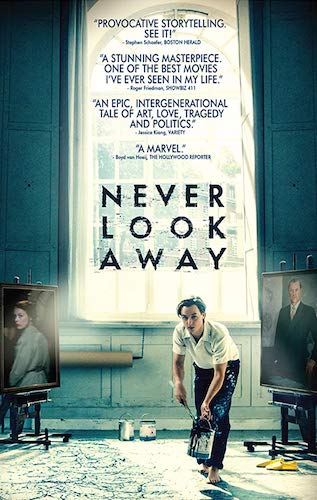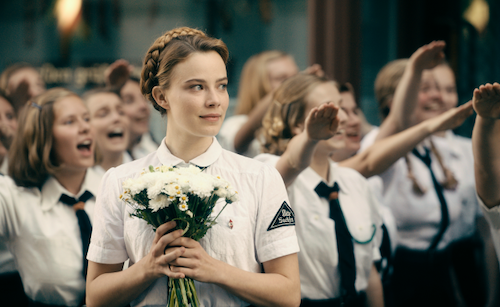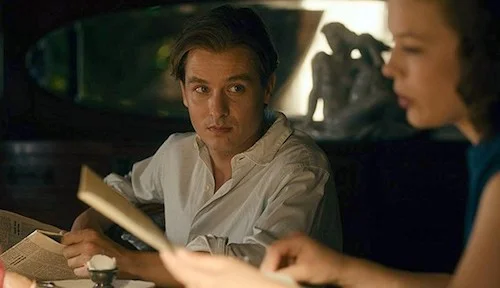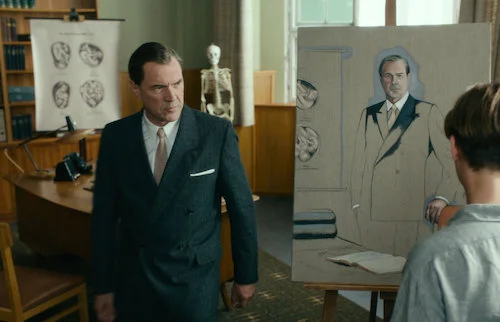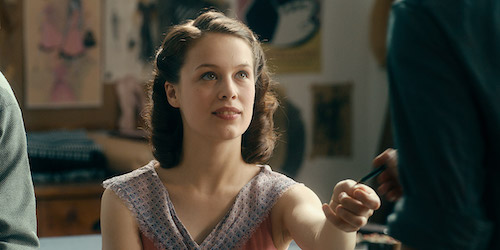Never Look Away
Maybe once a year, I come across the annual incarnation of what I call the “A Beautiful Mind” film. A Beautiful Mind is a story with many issues, but its emotional tidal wave is impossible to avoid. You get crushed with such great weight, and it doesn’t even necessarily feel like guilt tripping. You feel like you want to cry to this film at your own accord. This is because A Beautiful Mind doesn’t really try to make you feel sad, happy, angry or scared. It just wants to take you some place spiritually. When it comes to story telling, this film is weak because of its many flaws; however, you simply have to separate your mind from your heart with the film, and rank it a bit higher because it did work on you. Yes, every year or so has their own reincarnation of A Beautiful Mind. For 2018, it’s Never Look Away.
The first film by Florian Henckel von Donnersmarck since the unapologetically god awful The Tourist, this romantic epic is vastly superior (thank goodness) in every way, shape and form. I’m going to give this film a benefit that many critics are refusing to agree with: its run time. Three hours — to this humble writer — feels like just enough time. Not one second felt like an overstayed visit. All of this works in relation to Kurt’s artistic realizations. We need this much time to see every trial-and-error, and to have his “eureka” moment feel truly justifiable; this is especially true, since this moment lasts for a long time, and we need each and every domino-effect causation to feel natural. Once we reach this climax of this particular plot line, it’s like striking oil, only to find a pot of gold, the Holy Grail, and Carmen Sandiego all in the same bunker below the spillage.
The character Elizabeth May in an early scene.
To reach this moment, we have to understand Kurt inside and out. Kurt is loosely based on the real artist Gerhard Richter, whose abstract and hyper-realistic paintings broke much ground in the ‘60s, when painting was considered a dying art form. Aside from one of Richter’s iconic styles (one I won’t spoil, in case you want to go into the film blindly), there are only very few similarities between his life and Never Look Away’s plot. Richter did get affected by the Nazi movements in Germany, and struggle to get off the ground after attending a number of academies. However, that’s about it. His schizophrenic sister is turned into an aunt in Never Look Away (Elizabeth May: an important figure in Kurt’s life). He meets a fellow art student that he falls in love with, who is connected to someone he would least expect. There is much embellishment here. However, knowing all of this, I don’t see the major problem. This isn’t passed off as a biopic. Hell, the name was even changed as to not pass off this film as even a loose interpretation of Richter’s life. This is merely a story influenced by a real artist, and that’s that.
Kurt and Ellie.
Knowing all of this, let’s move on and discuss the film as a film (and not an encyclopedia). The film really takes its time developing Kurt from a wide-eyed child who has seen it all, to a conflicted adult that cannot process literally all of the information he has received. He hangs on to his aunt’s suggestions to “never look away” from any traumatic experience, as there will be worth in anything beautiful (even hardships); this is while she is being dragged away to be taken to an asylum. From this point on, until the many turmoils, events and successes Kurt has, we see so many turning points but one: Kurt’s desire to “crack the code” of life (an idea instilled in him by his aunt).
Meanwhile, we begin to get a subplot involving a Nazi-identifying gynaecologist, who is great at his job but morally corrupt. We see a crossed connection, where this doctor (Professor Carl Seeband) comes into contact with Aunt May, after having been given instructions by Nazi superiors to kill off “genetically deficient” patients (as a means of creating a master race). We continue down Seeband’s story line for a little bit, until it stops abruptly. That is, until paths are crossed again, and Seeband returns in the most damning way.
I don’t wish to keep explaining the plot, because this film is best experienced with as little exposure as possible. It’s about discovering all of life’s mysteries in succession. What I can describe with my limited lexicon are the aesthetics that are almost too gorgeous to digest. The score, a breathtaking series of songs by Max Richter (no relation to Gerhard, despite the coincidence) is the kind that is impossible to shake off. As the film keeps going, each and every iteration of a song (or use of a different song) layers on top of the previous instances, and you will absolutely feel the emotional build up in your heart waiting to explode. Then there is the stunning cinematography by the always-wonderful Caleb Deschanel. Every scene feels like a piece of art, with the use of soft pastel and earthy colours. Light and shadows are used with a great balance, and neither element dominates the film entirely. You truly feel like you are Kurt experience the beauty of the world around you; it truly is refuelling footage.
Ellie in an early scene.
The film goes through many European art movements, and this aspect alone makes Never Look Away essential for any lover of the arts. We start off with the visit to a Degenerate Art Museum (galleries used to exhibit pieces of the oppressed before it gets destroyed for good, mainly to mock), which left an impression on a young Kurt. We press on through war time propaganda, industrial painting (mainly sign creation), mural designing, socialist movements, and experimental artwork in the ‘60s. Kurt experiences it all, and evolves accordingly. Seeing one artist experience all of these shifts in history is exhilarating. No wonder why Donnersmarck wanted to at least use Richter’s life as a basis; there was definitely a great starting point for where Never Look Away could begin.
Then there are the problems that sadly turn Never Look Away from a flawless masterpiece into the A Beautiful Mind of the year. This part involves spoilers, so please avoid this section if you do not wish to have any moment ruined for you.
SPOILERS
The first main issue, is wondering whether or not Kurt actually knew about Carl being Ellie’s (his girlfriend/wife) father. It doesn’t quite make sense as to why he would not discuss this with Ellie, outside of maybe not wanting to shoo her away and trying to face his problems head on (as was advised by his aunt). His knowledge of Carl being the murderer of his aunt would make sense, as to how he responds to entering Carl’s doctors office for the first time (and visiting the corner she hid in); this only raises another problem, since we never saw Kurt seeing Elisabeth being carried out of the room to be operated on, yet he is aware of the space in which it happened. Either way, one problem’s possible solution only creates another problem. If we argue that Kurt did not know, why would he paint Carl’s portrait towards the end of the film, outside of the serendipity created by his working environment? Why would he consciously include his painting in the collage of people responsible for his aunt’s death? This story line never quite adds up, no matter which way you look at it. Apply this logic to other plot threads, including Ellie magically being able to have a child for no rhyme or reason after having been tampered with by her own father (so she could never bear children again).
SPOILERS CONCLUDE HERE
Outside of these major story flaws, Never Look Away is pure brilliance, and I do not care what the masses say. This is the kind of film that is far from perfect in some ways, but is absolutely spotless in others; this is the kind of film that I would absolutely love to watch again down the road despite its mistakes. Enduring the three hour length was not a challenge, outside of trying to hold back the tears for a good half of the film. There might be a skewed message here about art, especially the inability to label art in one specific way. That hardly matters, when the experience itself is so glorious. Aunt May’s advice to stare at any instance with beauty no matter what applies here. Never Look Away is worth the shot for its strengths alone. Its highs are some of the most euphoric of the year.
Andreas Babiolakis has a Masters degree in Film and Photography Preservation and Collections management from Ryerson University, as well as a Bachelors degree in Cinema Studies from York University. His favourite times of year are the Criterion Collection flash sales and the annual Toronto International Film Festival.

